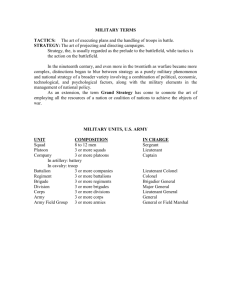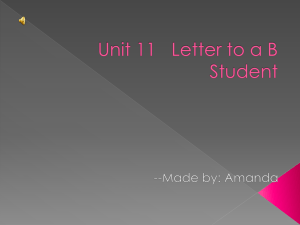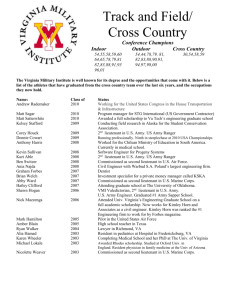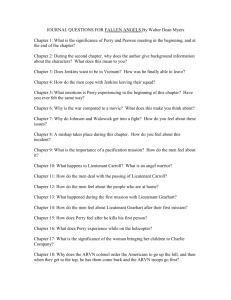attack
advertisement
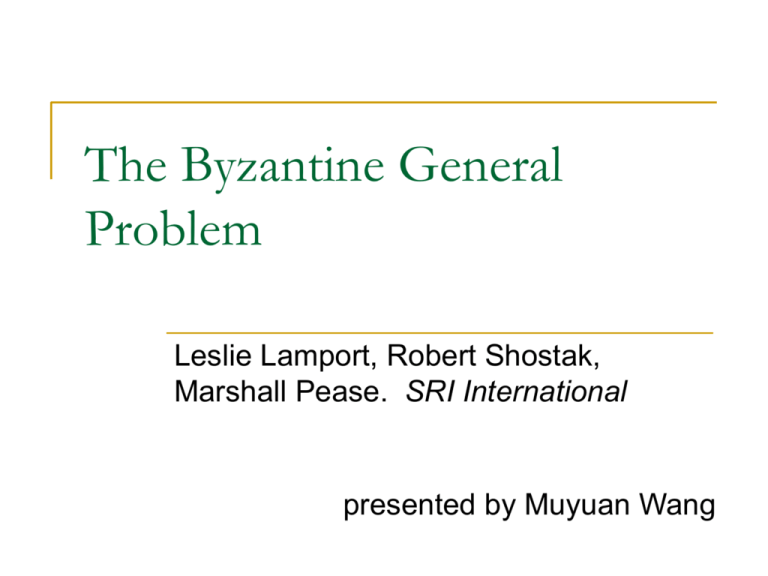
The Byzantine General
Problem
Leslie Lamport, Robert Shostak,
Marshall Pease. SRI International
presented by Muyuan Wang
Once upon a time...
Some of them may be traitors
who will try to confuse the
others
Communicating only
by messenger
Generals must agree
upon a common
battle plan
The pictures are taken from: R. Goscinny and A. Uderzo, Asterix and Latraviata.
Byzantine Generals Problem & Impossible
Results
Find an algorithm
Remodeled as a commanding general sending an
order to his lieutenants
To ensure that the loyal generals will reach agreement
A small number of traitors cannot cause the loyal generals
to adopt a bad plan
IC1: All loyal generals get same result
IC2: If commander is loyal, all loyal generals follow his
choice
No solution will work unless there are more than 2/3
loyal ones
Example: Poor Lieutenant 1’s Dilemma
Commander
Lieutenant 1
He said retreat
Lieutenant 2 (Traitor)
Commander (Traitor)
IC1 violated !
The two situations
are identical to me!
Lieutenant 1
Attack
He said retreat
Lieutenant 2
Retreat
Solutions
Solution 1: Using Oral Messages
Solution 2: Using Signed Messages
Solution using Oral Message
Solution for more than 3m+1 generals with m traitors
Oral messages:
Function 'majority':
With the property that if a majority of the values vi equals v, then
majority(v1,...,vn-1) equals v.
Order set Vi
Every message that is sent is delivered correctly
The receiver of a message knows who sent it
The absence of a message can be detected
Each lieutenant uses it to store orders from others
Algorithm OM(m) can deal with m traitors
Defined recursively
Base case: OM(0)
Commander 0
Commander sends messages
to Lieutenants
Each Lieutenant receives and
records it.
attack
Lieutenant i
Lieutenant j
Lieutenant k
Vi ={v0:attack}
Vi ={v0:attack}
Vi ={v0:attack}
OM(m)
Commander
Each Lieutenant act as the
commander in OM(m-1)
Send messages to ‘his’
Lieutenants
Do this recursively
attack
attack
attack
……
Lieutenant i
Lieutenant j
attack
Lieutenant k
Step 3: Majority Vote
Commander
For any m, Algorithm OM(m)
satisfies conditions IC1 and IC2
if there are more than 3m
generals and at most m traitors
My decision is:
majority(v1,v2,…,v_n-1)
Me too
Me too
……
Lieutenant 1
Lieutenant 2
Lieutenant n-1
OM(1): Lieutenant 3 is a traitor
Commander
IC1 achieved
IC2 achieved
Majority(attack,attack,attack)
=attack
Attack
Majority(attack,attack,retreat)
=attack
Attack
Attack
Attack
Lieutenant 1
Lieutenant 2
Attack
Attack
Retreat
Lieutenant 3 (Traitor)
OM(1): Commander is a traitor
Commander (Traitor)
IC1 achieved
IC2 need not be satisfied
Retreat
Majority(attack,retreat,retreat)
=retreat
Majority(attack,retreat,retreat)
=retreat
Attack
Retreat
Retreat
Lieutenant 1
Majority(attack,retreat,retreat)
=retreat
Retreat
Lieutenant 2
Attack
Retreat
Lieutenant 3
Solution with Signed Messages
What is a signed message?
Function choice(V): decision making
A loyal general's signature cannot be forged, and any
alteration of the contents of his signed messages can be
detected
Anyone can verify the authenticity of a general's signature
If the set V consists of the single element v, then
choice(V)=v
Note: no other characteristics needed for choice(V)
Step 1
Commander
sends message to
each Lieutenant
For any Lieutenant i, if he
receives the v:0 message and he
has not received any order yet
Commander (Traitor)
Let
Vi={v}
Send v:0:i to other lieutenants
attack:0:i
Vj={attack}
Vj={attack,attack}
Lieutenant j
attack:0:i
Lieutenant i
Vi={attack}
Lieutenant k
Vk={retreat}
Vk={retreat,attack}
Step 2
If
Lieutenant i receives a
Commander (Traitor)
message of v:0:j1:…:jk, and v is
NOT in set Vi, then
Add
If
v to Vi
k<m, send v:0:j1:…:jk:i to every
lieutenant except j1,…,jk
When
any Lieutenant i will
receive no more messages
Make
Vj={attack,attack,retreat}
decision using choice(Vi)
They get
the same order set!
Vi=Vj=Vk
Lieutenant i
Vi={attack,attack,retreat}
Lieutenant j
Lieutenant k
Vk={attack,attack,retreat}
Example
Commander (Traitor)
For
any m, Algoritym SM(m)
solves the Byzantine Generals
Problem if there are at most m
traitors.
The traitor can not
cheat now!
They get same
information, thus
same decision
Retreat:0:2
Attack:0:1
Lieutenant 1
Lieutenant 2
V1 = {Attack,Retreat}
V2 = {Attack,Retreat}
Conclusion
The requirements (Interactive Consistency Condition)
IC1: All loyal generals get same result
IC2: If commander is loyal, all loyal generals follow his
choice
Theorems to remember:
1. For any m, Algorithm OM(m) satisfies conditions IC1 and
IC2 if there are more than 3m generals and at most m
traitors
2. For any m, Algorithm SM(m) solves the Byzantine
Generals Problem if there are at most m traitors.
Discussions
These solutions are not used in practice
Why?
What if the messages get lost a lot during
communication?
Are there any other way besides ‘majority’
and ‘same information’?
